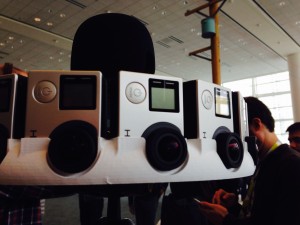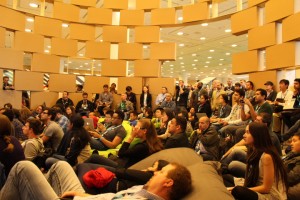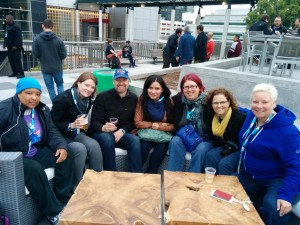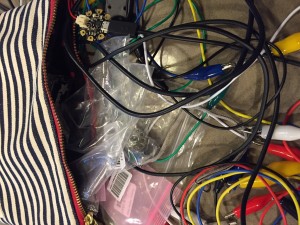
I wore my Google I/O t-shirt the other day while hiking, and realized I hadn’t posted a write up from that developer conference back in May 2015. This year they had a big push towards bringing women to the conference through effective methods.
Google has an Android developer community called Women Techmakers, led by Natalie Villabos. She did an amazing job with the event itself, but what most impressed me was the building of community prior to the event through the use of Slack, emailed communications, and networking opportunities both online and in person. Natalie said they went from 10% female attendees in 2013 to 23% this year. The first night I went to a Women Techmakers dinner was at an amazing Peruvian restaurant. The giveaways were lovely zippered canvas bags with Adafruit’s Gemma wearables package for hacking on later, which is awesome. I got the system working the other night, and ordered an additional soft potentiometer hoodie pull so I can make this project with the hoodie I bought at the conference.
This article offers a good overview of what they did to get more women to I/O. Here’s a short list:
- Grants
- Hackathons
- Nominations from Googlers
- Reserved invites to women coding groups
- Dinners together
- Network enablement such as a Slack channel before and after the event
I sat with three women at dinner: one is an engineer at Quora in SF, about a year out of college, the other was a product manager at Fox News in New York City for their app work, and the third I spoke to most is a developer at GreatSchools.net.
Faves and Raves
On Tap Now demo — or, how to not lose 20 minutes to your phone — was an example of a truly amazing context search. First, it brings us back to why we love Google in the first place. Second, she had a Skrillex song up and said, “OK Google, what’s his name.” I kid you not, I audibly gasped when it “just worked” and said “His name is John Moore.”
Expeditions gives Cardboard/VR to kids in classrooms. I went to this demo and it was pretty cool, we all sat on 360-degree swivel stools and turned to see what the “teacher” pointed us to in the VR screens. It was like having a fancy view finder. We went to Versailles in France, which I had very recently visited. It was impressive, but one aspect that threw me off was the cameras must have been super high off the ground. The Hall of Mirrors felt like I was floating through it rather than walking through it. But wow, what a cool experience for a classroom of kids. My second grader absolutely LOVED this.
Jump gives 16 cameras to do VR recording (Go Pro made one), Google assembler then makes it so you can interpolate the viewpoints and get 3 dimensions (depth-corrected stereo). 
I just read an article that said YouTube supports Cardboard for its videos now, here’s the help page.
Developer advocacy observations
Half the dev sessions were in these “alcoves” which were rooms created with cardboard tubes and boxes. It made for difficult hearing the presenter, even with mics on. Basically, no one left their comfy seating, so it was extremely hard to go around to different sessions.

I went to a Firebase demo, which had a great example of a developer advocate trying to identify with audience and do story telling. They did an example app that’s a chat application in a web browser that the audience could interact with right there. He could also turn the example chat off quickly if the crowd got out of hand in playing with it live. Side-by-side display made for a great demo as the noSQL updated before our very eyes.
Women at conferences, what’s in store?
As I reflect back on what it was like to go to a large tech conference with at least twice as many women as any I’d been to, I felt like the proof in the techniques to get us there is going to be in the return rate and the new signup rate. Will women feel like it was “their” conference too? Will they be annoyed with the overcrowding and not feel like it’s worth the extra effort to get on a plane? Will women keep returning because they’re there with their friends and it’s a tradition? Will women be more likely to spread the word about the conference itself to a wider group than just developers? I heard a woman explaining Google I/O to a man on the BART transit back to the airport, and thought, I haven’t seen much of that type of evangelism to the general public before. I think it’s going to take a while to see the effects of the special outreach efforts. I definitely think the diversity in networking effect is going to make a lasting change in the system. I sure hope so.
Summary
Lastly, I give you a great tweet from the guy in the hat in this picture said it with tongue in cheek, “14.2% men in tech at #io15.”

Here’s the code lab I worked through.
Here are talks I watched later:
To tell even more of the story, here are all my photos from Google I/O, appropriately uploaded to the announced-at-I/O Google Photos, with captions.
